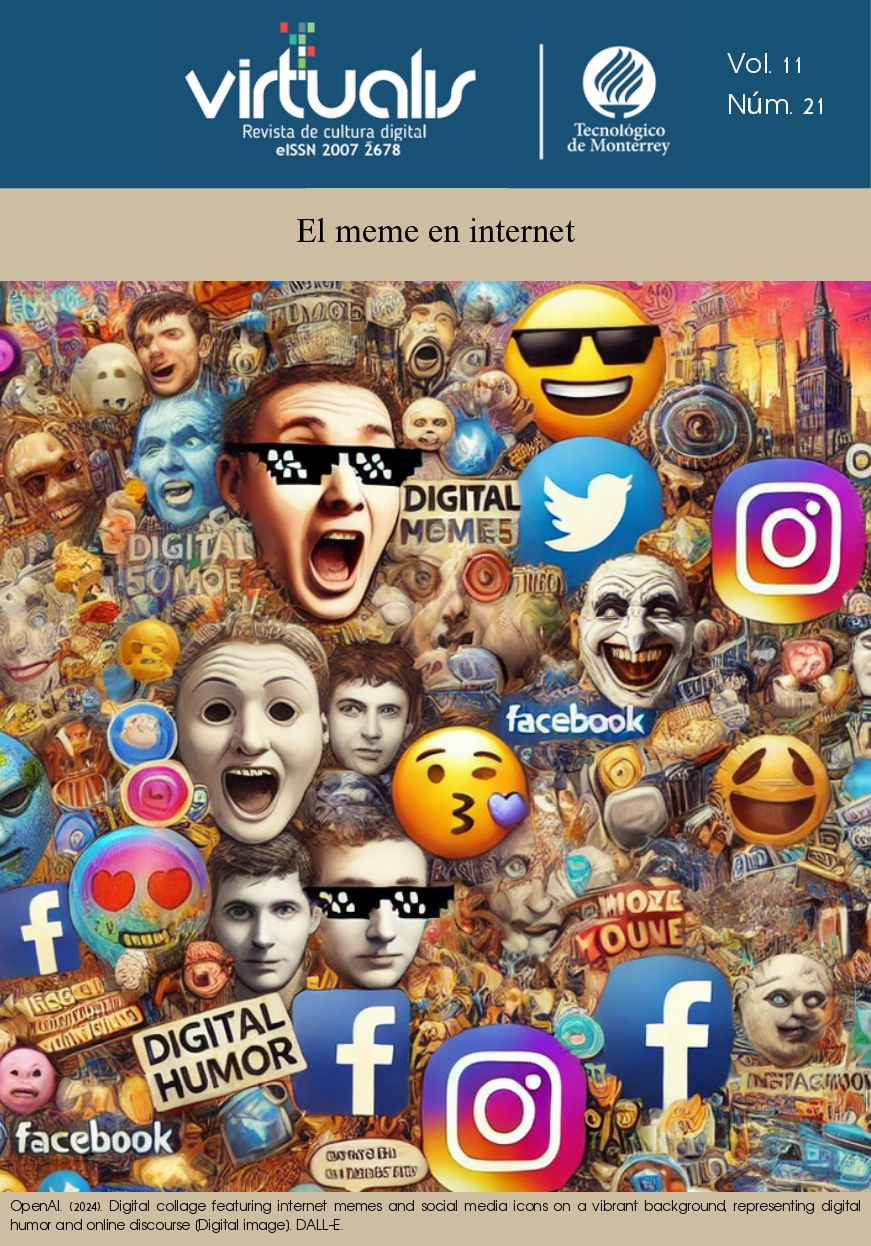Interactividad controlada entre élites políticas y ciudadanos: diálogos públicos en Facebook en las campañas electorales jaliscienses de 2018
Main Article Content
Acosta García, R. G. (2012). El diálogo y su calidad. Agenda de investigación sobre una herramienta social cotidiana. En R. G. Acosta García (Ed.), El diálogo como objeto de estudio (pp. 9-26). ITESO.
Adams, A., y McCorkindale, T. (2013). Dialogue and transparency: A content analysis of how the 2012 presidential candidates used twitter. Public Relations Review, 39(4), 357-359. https://doi.org/10.1016/j.pubrev.2013.07.016.
Alfaro Ramírez, Enrique (s/f). Home [Página de Facebook]. Facebook. Recuperado el 19 de diciembre de 2020: https://www.facebook.com/EnriqueAlfaroR/.
Anderson, E. (2011). Democracy, Public Policy, and Lay Assessments of Scientific Testimony. Episteme, 8(02), 144-164. https://doi.org/10.3366/epi.2011.0013.
Barassi, V., y Treré, E. (2012). Does Web 3.0 come after Web 2.0? Deconstructing theoretical assumptions through practice. New Media & Society, 14(8), 1269-1285. https://doi.org/10.1177/1461444812445878.
Bechmann, A., y Vahlstrup, P. B. (2015). Studying Facebook and Instagram data: The digital footprints software. First Monday. https://doi.org/10.5210/fm.v20i12.5968.
Benkler, Y., Faris, R., y Roberts, H. (2018). Network Propaganda: Manipulation, Disinformation, and Radicalization in American Politics. Oxford University Press.
Beauregard, L. P. (2017, septiembre 14). El Frente opositor de México nace en el Congreso. El País. https://elpais.com/internacional/2017/09/14/mexico/1505352641_935113.html
Bohman, J. (2006). Deliberative democracy and the epistemic benefits of diversity. Episteme, 3(03), 175-191. https://doi.org/10.3366/epi.2006.3.3.175.
Chadwick, A. (2017). The Hybrid Media System: Politics and Power (2a ed.). Oxford University Press.
Elmer, G. (2013). Live research: Twittering an election debate. New Media & Society, 15(1), 18€“30. https://doi.org/10.1177/1461444812457328
Larrosa-Fuentes, J. S. (2014). Twitter€™s Messages During a Governor Election: Abundance of One-Way, Top-down and Auto-Referential Communications and Scarcity of Public Dialogue. Global Media Journal México, 11(22). https://journals.tdl.org/gmjei/index.php/GMJ_EI/article/view/213
Larrosa-Fuentes, J. S. (2016). Deliberation and Conversation between Political Elites and Social Media Users During Guadalajara€™s Election: A Political Communication Systems Approach. Trípodos, 39, 109€“125. http://www.tripodos.com/index.php/Facultat_Comunicacio_Blanquerna/article/view/383
Lomelí Bolaños, Carlos (s/f). Home [Página de Facebook]. Facebook. Recuperado el 19 de diciembre de 2020: https://www.facebook.com/DrCarlosLomeli.
Castells, M. (2009). Comunicación y poder. Alianza.
Castells, M. (2012). Redes de indignación y esperanza: Los movimientos sociales en la era de Internet. Alianza Editorial.
Cogburn, D. L., y Espinoza-Vasquez, F. K. (2011). From networked nominee to networked nation: Examining the impact of Web 2.0 and social media on political participation and civic engagement in the 2008 Obama campaign. Journal of Political Marketing, 10(1-2), 189-213. https://doi.org/10.1080/15377857.2011.540224.
Davies, T., y Gangadharan, S. P. (Eds.). (2009). Online Deliberation: Design, Research, and Practice.
Dewey, J. (1927). The public and its problems: An essay in political inquiry (M. L. Rogers, Ed.). Penn State Press.
Duarte, L., & Larrosa-Fuentes, J. S. (2013). Comunidades virtuales y elecciones. En J. S. Larrosa-Fuentes & M. M. S. Paláu Cardona (Eds.), Medios de comunicación y derecho a la información en Jalisco, 2013. Análisis del sistema de comunicación política de Jalisco durante las campañas electorales a gobernador (pp. 161€“177). ITESO, Departamento de Estudios Socioculturales. http://qmedios.iteso.mx/wp-content/uploads/2014/02/08-Comunidades.pdf
Enli, G. (2017). Twitter as arena for the authentic outsider: Exploring the social media campaigns of Trump and Clinton in the 2016 US presidential election. European Journal of Communication, 32(1), 50-61. https://doi.org/10.1177/0267323116682802.
Ferber, P., Foltz, F., y Pugliese, R. (2007). Cyberdemocracy and online politics: A new model of interactivity. Bulletin of Science, Technology & Society, 27(5), 391-400. https://doi.org/10.1177/0270467607304559.
Fernandes, J., Giurcanu, M., Bowers, K. W., y Neely, J. C. (2010). The writing on the wall: A content analysis of college students€™ Facebook groups for the 2008 presidential election. Mass Communication and Society, 13(5), 653-675. https://doi.org/10.1080/15205436.2010.516865.
Friess, D., y Eilders, C. (2015). A systematic review of online deliberation research. Policy & Internet, 7(3), 319-339. https://doi.org/10.1002/poi3.95.
Graham, T., Broersma, M., Hazelhoff, K., y Van€™t Haar, G. (2013). Between broadcasting political messages and interacting with voters. Information, Communication & Society, 16(5), 692-716. https://doi.org/10.1080/1369118X.2013.785581.
Gunn, E. (2015). Mediated authenticity: How the media constructs reality. Peter Lang.
Habermas, J. (2006). Political communication in media society: Does democracy still enjoy an epistemic dimension? The impact of normative theory on empirical research. Communication Theory, 16(4), 411-426. https://doi.org/10.1111/j.1468-2885.2006.00280.x.
Halpern, D., y Gibbs, J. (2013). Social media as a catalyst for online deliberation? Exploring the affordances of Facebook and YouTube for political expression. Computers in Human Behavior, 29(3), 1159-1168. https://doi.org/10.1016/j.chb.2012.10.008.
Hernández Fuentes, M. (2018, septiembre 9). Premia Alfaro a sus empresas mimadas. NTR Guadalajara. http://www.ntrguadalajara.com/post.php?id_nota=107782.
Hogan, B. (2011). Chapter 11€”visualizing and interpreting Facebook networks. En D. L. Hansen, B. Shneiderman, y M. A. Smith (Eds.), Analyzing social media networks with NodeXL (pp. 165-179). Morgan Kaufmann. http://www.sciencedirect.com/science/article/pii/B9780123822291000114.
Instituto Federal de Telecomunicaciones. (2018). Anuario estadístico 2018 (p. 220). Instituto Federal de Telecomunicaciones.
Instituto Nacional de Estadística y Geografía. (2017). Encuesta nacional sobre disponibilidad y uso de tecnologías de la información en los hogares 2017. INEGI. http://www.beta.inegi.org.mx/proyectos/enchogares/regulares/dutih/2017/default.html?platform=hootsuite.
Jackson, N. A., y Lilleker, D. G. (2009). Building an architecture of participation? Political parties and Web 2.0 in Britain. Journal of Information Technology & Politics, 6(3-4), 232-250. https://doi.org/10.1080/19331680903028438.
Kreiss, D. (2016). Prototype politics: Technology-intensive campaigning and the data of democracy. Oxford University Press.
Luker, K. (2010). Salsa Dancing Into the Social Sciences: Research in an Age of Info-Glut. Harvard University Press.
Macnamara, J. (2011). Pre and post-election 2010 online: What happened to the conversation? Communication, Politics & Culture, 41(1). http://epress.lib.uts.edu.au/research/handle/10453/17356.
Manosevitch, I. (2014). The design of online deliberation: Implications for practice, theory and democratic citizenship. Journal of Public Deliberation, 10(1). http://www.publicdeliberation.net/jpd/vol10/iss1/art9.
Mckee, A. (2003). Textual Analysis. SAGE.
Castro Reynoso, Miguel. (s/f). Home [Página de Facebook]. Facebook. Recuperado el 19 de diciembre de 2020: https://www.facebook.com/miguelcastroreynoso/.
Muñiz, C., Dader, J. L., Téllez, N. M., y Salazar, A. (2016). ¿Están los políticos políticamente comprometidos? Análisis del compromiso político 2.0 desarrollado por los candidatos a través de Facebook. Cuadernos.info, 0(39), 135-150. https://doi.org/10.7764/cdi.39.970.
Newman, N., Fletcher, R., Kalogeropoulos, A., Levy, D. A. L., y Nielsen, R. K. (2018). Reuters Institute digital news report 2018 (p. 144). Reuters Institute for the Study of Journalism. http://media.digitalnewsreport.org/wp-content/uploads/2018/06/digital-news-report-2018.pdf?x89475.
Nielsen, R. K. (2012). Ground wars: Personalized communication in political campaigns. Princeton University Press.
O€™Reilly, T. (2005, septiembre 30). What is Web 2.0: Design patterns and business models for the next generation of software. O€™Reilly. http://oreilly.com/web2/archive/what-is-web-20.html.
Powell, L., y Cowart, J. (2017). Political campaign communication: Inside and out (3rd ed.). Taylor & Francis Group.
Rivera-Magos, S., y Negrete-Huelga, K. (2019). Elecciones 2.0 en México. Análisis de estrategias de comunicación en Facebook de los candidatos presidenciales de 2018. Revista Mexicana de Opinión Pública, 1(28), 94-113. http://dx.doi.org/10.22201/fcpys.24484911e.2020.28.70191.
Robles, P. (2012, junio 6). Los dueños de la comunicación política. Reporte Ãndigo. http://www.indiga.co/reporte/guadalajara/los-duenos-de-la-comunicacion-politica.
Segado-Boj, F., Díaz-Campo, J., y Sobrado, B. L. (2016). Objetivos y estrategias de los políticos españoles en Twitter. index.comunicación, 6(1), 77-98. http://journals.sfu.ca/indexcomunicacion/index.php/indexcomunicacion/article/view/244
Stromer-Galley, J. (2004). Interactivity-as-Product and Interactivity-as-Process. The Information Society, 20(5), 391-394. https://doi.org/10.1080/01972240490508081.
Stromer-Galley, J. (2014). Presidential campaigning in the internet age. Oxford University Press.
Sweetser, K. D., y Lariscy, R. W. (2008). Candidates make good friends: An analysis of candidates€™ uses of Facebook. International Journal of Strategic Communication, 2(3), 175-198. https://doi.org/10.1080/15531180802178687.
Toxtle Tlachino, A. (2019). Procesos comunicativos y deliberativos en Facebook durante campañas electorales: Caso Andrés Manuel López Obrador en 2018 [Tesis de Maestría, Benemérita Universidad Autónoma de Puebla]. https://repositorioinstitucional.buap.mx/handle/20.500.12371/4499.
Tufekci, Z. (2017). Twitter and Tear Gas. Yale University Press.
Valenzuela Cardona, R. (2018, enero 29). Quién es quién en Facebook en Jalisco. El Informador. https://www.informador.mx/ideas/Quien-es-quien-en-Facebook-en-Jalisco-20180126-0125.html.
Wright, S. (2009). The role of the moderator: Problems and possibilities for government-run online discussion forums. En T. Davies y S. P. Gangadharan (Eds.), Online deliberation: Design, research, and practice (pp. 233-242). CSLI Publications / University of Chicago Press.

 Blog
Blog
 Instagram
Instagram
 Google
Google
 Tec de Monterrey
Tec de Monterrey

